Lixin Duan
Nanyang Technological University
Discrete Scale-invariant Metric Learning for Efficient Collaborative Filtering
Jun 11, 2025Abstract:Metric learning has attracted extensive interest for its ability to provide personalized recommendations based on the importance of observed user-item interactions. Current metric learning methods aim to push negative items away from the corresponding users and positive items by an absolute geometrical distance margin. However, items may come from imbalanced categories with different intra-class variations. Thus, the absolute distance margin may not be ideal for estimating the difference between user preferences over imbalanced items. To this end, we propose a new method, named discrete scale-invariant metric learning (DSIML), by adding binary constraints to users and items, which maps users and items into binary codes of a shared Hamming subspace to speed up the online recommendation. Specifically, we firstly propose a scale-invariant margin based on angles at the negative item points in the shared Hamming subspace. Then, we derive a scale-invariant triple hinge loss based on the margin. To capture more preference difference information, we integrate a pairwise ranking loss into the scale-invariant loss in the proposed model. Due to the difficulty of directly optimizing the mixed integer optimization problem formulated with \textit{log-sum-exp} functions, we seek to optimize its variational quadratic upper bound and learn hash codes with an alternating optimization strategy. Experiments on benchmark datasets clearly show that our proposed method is superior to competitive metric learning and hashing-based baselines for recommender systems. The implementation code is available at https://github.com/AnonyFeb/dsml.
Semantic segmentation with reward
May 23, 2025Abstract:In real-world scenarios, pixel-level labeling is not always available. Sometimes, we need a semantic segmentation network, and even a visual encoder can have a high compatibility, and can be trained using various types of feedback beyond traditional labels, such as feedback that indicates the quality of the parsing results. To tackle this issue, we proposed RSS (Reward in Semantic Segmentation), the first practical application of reward-based reinforcement learning on pure semantic segmentation offered in two granular levels (pixel-level and image-level). RSS incorporates various novel technologies, such as progressive scale rewards (PSR) and pair-wise spatial difference (PSD), to ensure that the reward facilitates the convergence of the semantic segmentation network, especially under image-level rewards. Experiments and visualizations on benchmark datasets demonstrate that the proposed RSS can successfully ensure the convergence of the semantic segmentation network on two levels of rewards. Additionally, the RSS, which utilizes an image-level reward, outperforms existing weakly supervised methods that also rely solely on image-level signals during training.
VPNeXt -- Rethinking Dense Decoding for Plain Vision Transformer
Feb 25, 2025Abstract:We present VPNeXt, a new and simple model for the Plain Vision Transformer (ViT). Unlike the many related studies that share the same homogeneous paradigms, VPNeXt offers a fresh perspective on dense representation based on ViT. In more detail, the proposed VPNeXt addressed two concerns about the existing paradigm: (1) Is it necessary to use a complex Transformer Mask Decoder architecture to obtain good representations? (2) Does the Plain ViT really need to depend on the mock pyramid feature for upsampling? For (1), we investigated the potential underlying reasons that contributed to the effectiveness of the Transformer Decoder and introduced the Visual Context Replay (VCR) to achieve similar effects efficiently. For (2), we introduced the ViTUp module. This module fully utilizes the previously overlooked ViT real pyramid feature to achieve better upsampling results compared to the earlier mock pyramid feature. This represents the first instance of such functionality in the field of semantic segmentation for Plain ViT. We performed ablation studies on related modules to verify their effectiveness gradually. We conducted relevant comparative experiments and visualizations to show that VPNeXt achieved state-of-the-art performance with a simple and effective design. Moreover, the proposed VPNeXt significantly exceeded the long-established mIoU wall/barrier of the VOC2012 dataset, setting a new state-of-the-art by a large margin, which also stands as the largest improvement since 2015.
The Devil is in the Spurious Correlation: Boosting Moment Retrieval via Temporal Dynamic Learning
Jan 13, 2025Abstract:Given a textual query along with a corresponding video, the objective of moment retrieval aims to localize the moments relevant to the query within the video. While commendable results have been demonstrated by existing transformer-based approaches, predicting the accurate temporal span of the target moment is currently still a major challenge. In this paper, we reveal that a crucial reason stems from the spurious correlation between the text queries and the moment context. Namely, the model may associate the textual query with the background frames rather than the target moment. To address this issue, we propose a temporal dynamic learning approach for moment retrieval, where two strategies are designed to mitigate the spurious correlation. First, we introduce a novel video synthesis approach to construct a dynamic context for the relevant moment. With separate yet similar videos mixed up, the synthesis approach empowers our model to attend to the target moment of the corresponding query under various dynamic contexts. Second, we enhance the representation by learning temporal dynamics. Besides the visual representation, text queries are aligned with temporal dynamic representations, which enables our model to establish a non-spurious correlation between the query-related moment and context. With the aforementioned proposed method, the spurious correlation issue in moment retrieval can be largely alleviated. Our method establishes a new state-of-the-art performance on two popular benchmarks of moment retrieval, \ie, QVHighlights and Charades-STA. In addition, the detailed ablation analyses demonstrate the effectiveness of the proposed strategies. Our code will be publicly available.
Towards Unsupervised Model Selection for Domain Adaptive Object Detection
Dec 23, 2024Abstract:Evaluating the performance of deep models in new scenarios has drawn increasing attention in recent years. However, while it is possible to collect data from new scenarios, the annotations are not always available. Existing DAOD methods often rely on validation or test sets on the target domain for model selection, which is impractical in real-world applications. In this paper, we propose a novel unsupervised model selection approach for domain adaptive object detection, which is able to select almost the optimal model for the target domain without using any target labels. Our approach is based on the flat minima principle, i,e., models located in the flat minima region in the parameter space usually exhibit excellent generalization ability. However, traditional methods require labeled data to evaluate how well a model is located in the flat minima region, which is unrealistic for the DAOD task. Therefore, we design a Detection Adaptation Score (DAS) approach to approximately measure the flat minima without using target labels. We show via a generalization bound that the flatness can be deemed as model variance, while the minima depend on the domain distribution distance for the DAOD task. Accordingly, we propose a Flatness Index Score (FIS) to assess the flatness by measuring the classification and localization fluctuation before and after perturbations of model parameters and a Prototypical Distance Ratio (PDR) score to seek the minima by measuring the transferability and discriminability of the models. In this way, the proposed DAS approach can effectively evaluate the model generalization ability on the target domain. We have conducted extensive experiments on various DAOD benchmarks and approaches, and the experimental results show that the proposed DAS correlates well with the performance of DAOD models and can be used as an effective tool for model selection after training.
S-INF: Towards Realistic Indoor Scene Synthesis via Scene Implicit Neural Field
Dec 23, 2024Abstract:Learning-based methods have become increasingly popular in 3D indoor scene synthesis (ISS), showing superior performance over traditional optimization-based approaches. These learning-based methods typically model distributions on simple yet explicit scene representations using generative models. However, due to the oversimplified explicit representations that overlook detailed information and the lack of guidance from multimodal relationships within the scene, most learning-based methods struggle to generate indoor scenes with realistic object arrangements and styles. In this paper, we introduce a new method, Scene Implicit Neural Field (S-INF), for indoor scene synthesis, aiming to learn meaningful representations of multimodal relationships, to enhance the realism of indoor scene synthesis. S-INF assumes that the scene layout is often related to the object-detailed information. It disentangles the multimodal relationships into scene layout relationships and detailed object relationships, fusing them later through implicit neural fields (INFs). By learning specialized scene layout relationships and projecting them into S-INF, we achieve a realistic generation of scene layout. Additionally, S-INF captures dense and detailed object relationships through differentiable rendering, ensuring stylistic consistency across objects. Through extensive experiments on the benchmark 3D-FRONT dataset, we demonstrate that our method consistently achieves state-of-the-art performance under different types of ISS.
ResCLIP: Residual Attention for Training-free Dense Vision-language Inference
Nov 24, 2024Abstract:While vision-language models like CLIP have shown remarkable success in open-vocabulary tasks, their application is currently confined to image-level tasks, and they still struggle with dense predictions. Recent works often attribute such deficiency in dense predictions to the self-attention layers in the final block, and have achieved commendable results by modifying the original query-key attention to self-correlation attention, (e.g., query-query and key-key attention). However, these methods overlook the cross-correlation attention (query-key) properties, which capture the rich spatial correspondence. In this paper, we reveal that the cross-correlation of the self-attention in CLIP's non-final layers also exhibits localization properties. Therefore, we propose the Residual Cross-correlation Self-attention (RCS) module, which leverages the cross-correlation self-attention from intermediate layers to remold the attention in the final block. The RCS module effectively reorganizes spatial information, unleashing the localization potential within CLIP for dense vision-language inference. Furthermore, to enhance the focus on regions of the same categories and local consistency, we propose the Semantic Feedback Refinement (SFR) module, which utilizes semantic segmentation maps to further adjust the attention scores. By integrating these two strategies, our method, termed ResCLIP, can be easily incorporated into existing approaches as a plug-and-play module, significantly boosting their performance in dense vision-language inference. Extensive experiments across multiple standard benchmarks demonstrate that our method surpasses state-of-the-art training-free methods, validating the effectiveness of the proposed approach. Code is available at https://github.com/yvhangyang/ResCLIP.
TransUNext: towards a more advanced U-shaped framework for automatic vessel segmentation in the fundus image
Nov 05, 2024



Abstract:Purpose: Automatic and accurate segmentation of fundus vessel images has become an essential prerequisite for computer-aided diagnosis of ophthalmic diseases such as diabetes mellitus. The task of high-precision retinal vessel segmentation still faces difficulties due to the low contrast between the branch ends of retinal vessels and the background, the long and thin vessel span, and the variable morphology of the optic disc and optic cup in fundus vessel images. Methods: We propose a more advanced U-shaped architecture for a hybrid Transformer and CNN: TransUNext, which integrates an Efficient Self-attention Mechanism into the encoder and decoder of U-Net to capture both local features and global dependencies with minimal computational overhead. Meanwhile, the Global Multi-Scale Fusion (GMSF) module is further introduced to upgrade skip-connections, fuse high-level semantic and low-level detailed information, and eliminate high- and low-level semantic differences. Inspired by ConvNeXt, TransNeXt Block is designed to optimize the computational complexity of each base block in U-Net and avoid the information loss caused by the compressed dimension when the information is converted between the feature spaces of different dimensions. Results: We evaluated the proposed method on four public datasets DRIVE, STARE, CHASE-DB1, and HRF. In the experimental results, the AUC (area under the ROC curve) values were 0.9867, 0.9869, 0.9910, and 0.9887, which exceeded the other state-of-the-art.
Coherence-guided Preference Disentanglement for Cross-domain Recommendations
Oct 27, 2024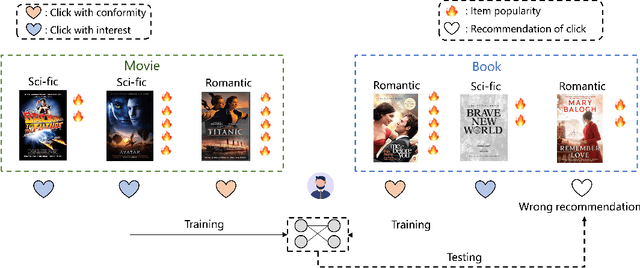
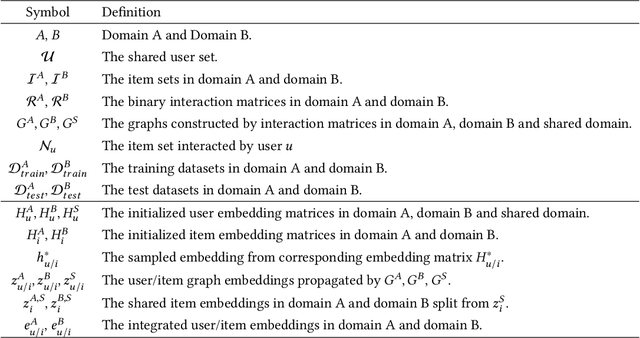
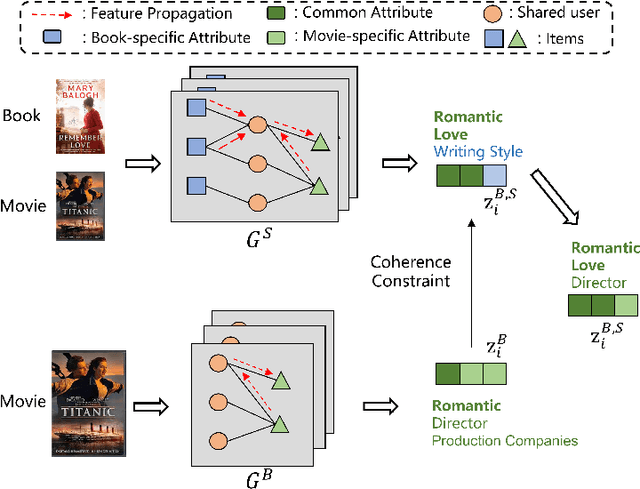
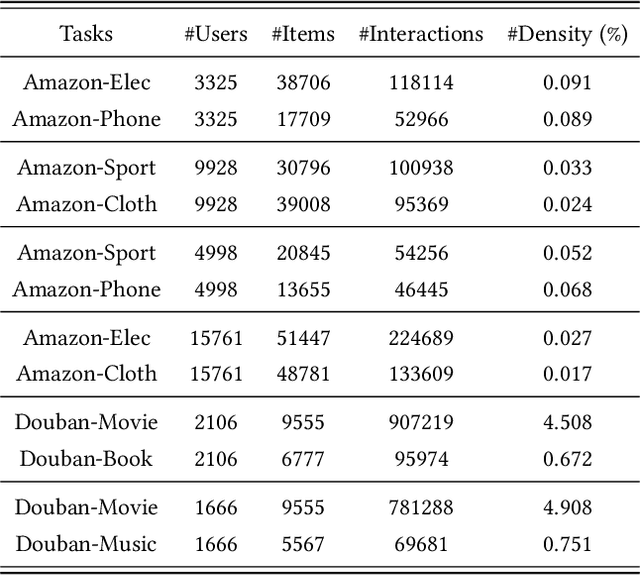
Abstract:Discovering user preferences across different domains is pivotal in cross-domain recommendation systems, particularly when platforms lack comprehensive user-item interactive data. The limited presence of shared users often hampers the effective modeling of common preferences. While leveraging shared items' attributes, such as category and popularity, can enhance cross-domain recommendation performance, the scarcity of shared items between domains has limited research in this area. To address this, we propose a Coherence-guided Preference Disentanglement (CoPD) method aimed at improving cross-domain recommendation by i) explicitly extracting shared item attributes to guide the learning of shared user preferences and ii) disentangling these preferences to identify specific user interests transferred between domains. CoPD introduces coherence constraints on item embeddings of shared and specific domains, aiding in extracting shared attributes. Moreover, it utilizes these attributes to guide the disentanglement of user preferences into separate embeddings for interest and conformity through a popularity-weighted loss. Experiments conducted on real-world datasets demonstrate the superior performance of our proposed CoPD over existing competitive baselines, highlighting its effectiveness in enhancing cross-domain recommendation performance.
Learning Semantic Latent Directions for Accurate and Controllable Human Motion Prediction
Jul 16, 2024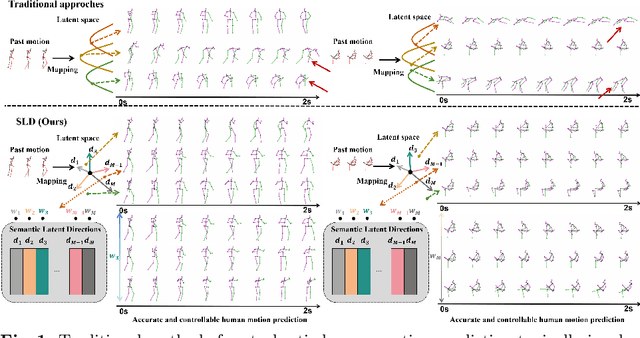
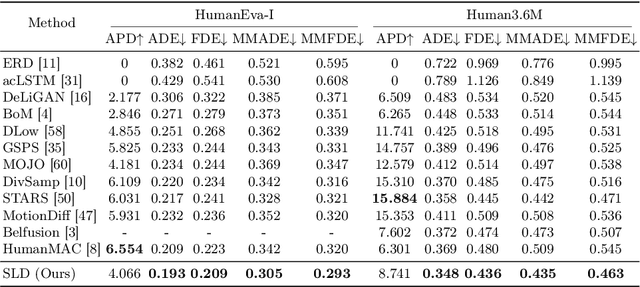
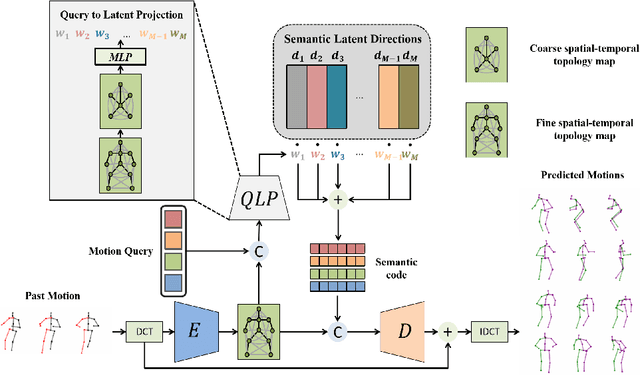

Abstract:In the realm of stochastic human motion prediction (SHMP), researchers have often turned to generative models like GANS, VAEs and diffusion models. However, most previous approaches have struggled to accurately predict motions that are both realistic and coherent with past motion due to a lack of guidance on the latent distribution. In this paper, we introduce Semantic Latent Directions (SLD) as a solution to this challenge, aiming to constrain the latent space to learn meaningful motion semantics and enhance the accuracy of SHMP. SLD defines a series of orthogonal latent directions and represents the hypothesis of future motion as a linear combination of these directions. By creating such an information bottleneck, SLD excels in capturing meaningful motion semantics, thereby improving the precision of motion predictions. Moreover, SLD offers controllable prediction capabilities by adjusting the coefficients of the latent directions during the inference phase. Expanding on SLD, we introduce a set of motion queries to enhance the diversity of predictions. By aligning these motion queries with the SLD space, SLD is further promoted to more accurate and coherent motion predictions. Through extensive experiments conducted on widely used benchmarks, we showcase the superiority of our method in accurately predicting motions while maintaining a balance of realism and diversity. Our code and pretrained models are available at https://github.com/GuoweiXu368/SLD-HMP.
 Add to Chrome
Add to Chrome Add to Firefox
Add to Firefox Add to Edge
Add to Edge